Blue-eyed blonde Anna Lee (1913-2004) was a British-born American actress. She started her career in British films and earned the title 'Queen of the Quota Quickies'. In 1939, she moved to Hollywood with her husband, director Robert Stevenson. There, she often worked with John Ford and later became a TV star in the soap series General Hospital.

British Art Photo postcard, no. 37-1. Photo: Gaumont-British.
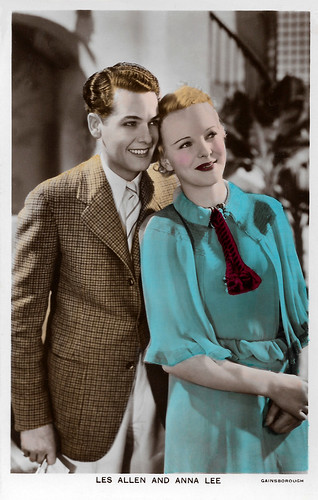
British postcard in the Film Partners Series, London, no. P 182. Photo: Gainsborough. Anna Lee and Les Allen in Heat Wave (Maurice Elvey, 1935).
Anna Lee was born Joan Boniface Winnifrith in 1913 in Ightham, Kent. She was the daughter of Bertram Thomas Winnifrith, a headmaster and Anglican rector who supported his daughter in her desire to become an actress, and his second wife, Edith Maude Digby-Roper. Her godmother was legendary actress Sybil Thorndike. Lee trained at the Royal Albert Hall, then made her debut with a bit part in the musical comedy His Lordship (Michael Powell, 1932) when she was 19. She played several minor, often uncredited, roles in films during the early 1930s. She gradually began to get more prominent roles in 'quota quickies', particularly those made for Paramount British.
Anna Lee became known for her roles in films set amongst the wealthy, particularly in Chelsea Life (Sidney Morgan, 1933), in which she starred with Louis Hayward. The film was set in the artistic community of Chelsea. On the strength of her performances in quota films, Lee signed a contract with Gainsborough Pictures in 1934. Gainsborough was the biggest British production company of the era.
She played leading lady roles in a variety of different genres at Gainsborough including the comedy-thriller The Camels Are Coming (Tim Whelan, 1934) with Jack Hulbert, the drama The Passing of the Third Floor Back (Bertold Viertel, 1935) starring Conrad Veidt, the horror film The Man Who Changed His Mind (Robert Stevenson, 1936) with Boris Karloff, and the war film OHMS (Raoul Walsh, 1937).
She appeared in the Jessie Matthews musical First a Girl (Victor Saville, 1935) as the aristocratic other woman. In 1937, she starred in one of the studio's large-budget productions, King Solomon's Mines (Robert Stevenson, 1937), starring Cedric Hardwicke and Paul Robeson. Anna Lee had met her first husband, the director Robert Stevenson, while shooting The Camels are Coming on location in Egypt. They married in 1934. In 1938, she took time off from acting to give birth to their first child. In 1939, she and her husband switched to Ealing Studios, which was now being run by Michael Balcon, the former head of Gainsborough.
She played a nineteenth century Irish music hall performer who falls in love with an aristocrat (Griffith Jones) in the comedy Young Man's Fancy (Robert Stevenson, 1939) and a journalist who helps the heroes thwart a foreign enemy's plot against Britain in The Four Just Men (Walter Forde, 1939). Her final film in Britain was Return to Yesterday (Robert Stevenson, 1940), about a young repertory theatre actress who falls in love with a Hollywood star (Clive Brook) she meets while touring in a small seaside town. With the Second World War imminent, she and Stevenson then went to the United States. During the war, Lee performed with Jack Benny and others in USO tours, entertaining troops in North Africa and Europe. General George Patton awarded her a special medal for her efforts. She remained supportive of the British war effort and, in 1943, appeared alongside other British actors in Forever and a Day (Rene Clair, a.o., 1943), which was made to raise money for British charities.
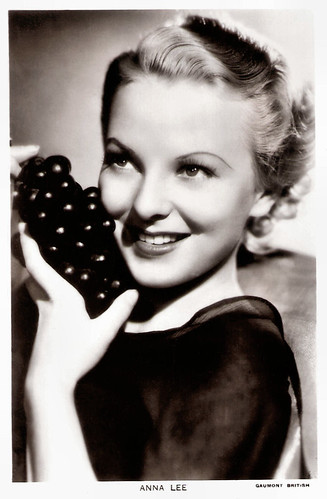
British postcard in the Picturegoer Series, London, no. 880b. Photo: Gaumont-British.
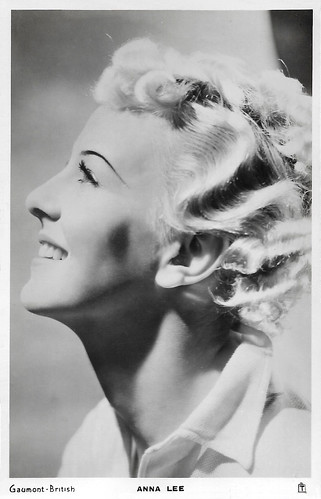
British Real Photograph postcard by Raphael Tuck & Sons, London. Photo: Gaumont-British.
In Hollywood, Anna Lee became associated with director John Ford. She appeared in several of his films, notably in How Green Was My Valley (1941), Fort Apache (1948) with John Wayne and Henry Fonda, and Two Rode Together (1961) with James Stewart and Richard Widmark. She co-starred with John Wayne and John Carroll in Flying Tigers (David Miller, 1942). She worked for producer Val Lewton opposite Boris Karloff in the horror thriller Bedlam (Mark Robson, 1946) and had a lead role opposite Brian Donlevy and Walter Brennan in Fritz Lang's Hangmen Also Die! (1943), a wartime thriller about the assassination of Reinhard Heydrich.
Lee made frequent appearances on television anthology series in the 1940s and 1950s, including Robert Montgomery Presents, The Ford Theatre Hour, Kraft Television Theatre, Armstrong Circle Theatre and Wagon Train. She made a guest appearance on Perry Mason as Crystal Durham in the episode The Case of the Unsuitable Uncle (1962). In 1958, she returned to Britain to appear in John Ford's Gideon's Day, in which she played the wife of the detective, played by Jack Hawkins. She had a small, but memorable, role as Sister Margaretta in The Sound of Music (Robert Wise, 1965), one of the two nuns who thwarted the Nazis by removing car engine parts, allowing the Von Trapps to escape.
Lee appeared in the Grand Guignol classic What Ever Happened to Baby Jane? (Robert Aldrich, 1962) in a small role as Mrs. Bates, a neighbour of the sisters played by Joan Crawford and Bette Davis. From 1979 on, she became known to a new generation as wealthy matriarch Lila Quartermaine on General Hospital and the spin-off Port Charles until being removed from contract and dropped to recurring status in 2003. In 1994, Lee took the leading role in the feature film What Can I Do? (Wheeler Winston Dixon, 1994). It was her final film role.
Anna Lee and her first husband, Robert Stevenson, had two daughters, Venetia and Caroline. Venetia Stevenson, an actress as well, was married to Don Everly of the Everly Brothers and has three children, Edan, Erin, and Stacy. Lee and Stevenson divorced in March 1944, with Venetia and Caroline electing to live with their father. She met her second husband, George Stafford, as the pilot of the plane on her USO tour during the Second World War. They married on 8 June 1944 and had three sons, John, Stephen and Tim Stafford. Tim is an actor under the stage name of Jeffrey Byron. Lee and Stafford divorced in 1964.
Her final marriage, to novelist Robert Nathan ('The Bishop's Wife', 'Portrait of Jennie'), in 1970, ended at his death in 1985. Lee became a naturalised US citizen under the name Joanna Boniface Stafford in 1945. In 1992, she was awarded the M.B.E. (Member of the Order of the British Empire) for her services to drama. In 2004, she was posthumously awarded a Daytime Emmy Lifetime Achievement Award; she was scheduled for months to receive the award, but died from pneumonia at age 91 before she could receive it. Her son, Jeffrey Byron, accepted the award on her behalf. On 16 July 2004, General Hospital aired a tribute to Lee by holding a memorial service for Lila Quartermaine.
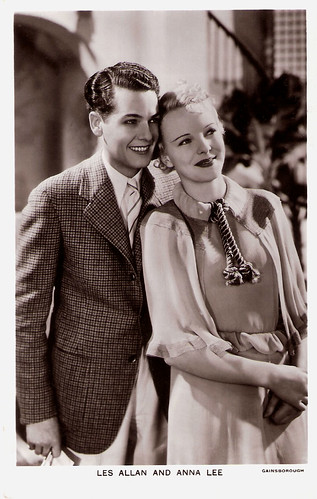
British postcard in the Film Partners Series, London, no. P 182. Photo: Gainsborough. Les Allen and Anna Lee in Heat Wave (Maurice Elvey, 1935).
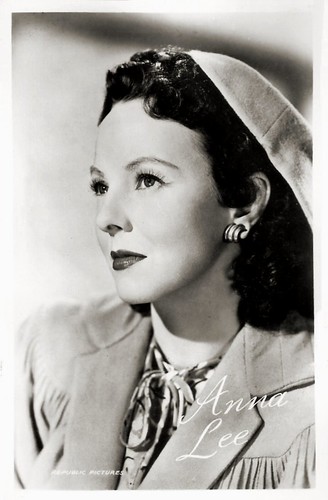
Dutch postcard, no. 3484. Photo: Republic Pictures.
Sources: Tom Weaver (IMDb), Wikipedia and IMDb.
This post was last updated on 11 March 2025.

British Art Photo postcard, no. 37-1. Photo: Gaumont-British.

British postcard in the Film Partners Series, London, no. P 182. Photo: Gainsborough. Anna Lee and Les Allen in Heat Wave (Maurice Elvey, 1935).
First a girl
Anna Lee was born Joan Boniface Winnifrith in 1913 in Ightham, Kent. She was the daughter of Bertram Thomas Winnifrith, a headmaster and Anglican rector who supported his daughter in her desire to become an actress, and his second wife, Edith Maude Digby-Roper. Her godmother was legendary actress Sybil Thorndike. Lee trained at the Royal Albert Hall, then made her debut with a bit part in the musical comedy His Lordship (Michael Powell, 1932) when she was 19. She played several minor, often uncredited, roles in films during the early 1930s. She gradually began to get more prominent roles in 'quota quickies', particularly those made for Paramount British.
Anna Lee became known for her roles in films set amongst the wealthy, particularly in Chelsea Life (Sidney Morgan, 1933), in which she starred with Louis Hayward. The film was set in the artistic community of Chelsea. On the strength of her performances in quota films, Lee signed a contract with Gainsborough Pictures in 1934. Gainsborough was the biggest British production company of the era.
She played leading lady roles in a variety of different genres at Gainsborough including the comedy-thriller The Camels Are Coming (Tim Whelan, 1934) with Jack Hulbert, the drama The Passing of the Third Floor Back (Bertold Viertel, 1935) starring Conrad Veidt, the horror film The Man Who Changed His Mind (Robert Stevenson, 1936) with Boris Karloff, and the war film OHMS (Raoul Walsh, 1937).
She appeared in the Jessie Matthews musical First a Girl (Victor Saville, 1935) as the aristocratic other woman. In 1937, she starred in one of the studio's large-budget productions, King Solomon's Mines (Robert Stevenson, 1937), starring Cedric Hardwicke and Paul Robeson. Anna Lee had met her first husband, the director Robert Stevenson, while shooting The Camels are Coming on location in Egypt. They married in 1934. In 1938, she took time off from acting to give birth to their first child. In 1939, she and her husband switched to Ealing Studios, which was now being run by Michael Balcon, the former head of Gainsborough.
She played a nineteenth century Irish music hall performer who falls in love with an aristocrat (Griffith Jones) in the comedy Young Man's Fancy (Robert Stevenson, 1939) and a journalist who helps the heroes thwart a foreign enemy's plot against Britain in The Four Just Men (Walter Forde, 1939). Her final film in Britain was Return to Yesterday (Robert Stevenson, 1940), about a young repertory theatre actress who falls in love with a Hollywood star (Clive Brook) she meets while touring in a small seaside town. With the Second World War imminent, she and Stevenson then went to the United States. During the war, Lee performed with Jack Benny and others in USO tours, entertaining troops in North Africa and Europe. General George Patton awarded her a special medal for her efforts. She remained supportive of the British war effort and, in 1943, appeared alongside other British actors in Forever and a Day (Rene Clair, a.o., 1943), which was made to raise money for British charities.

British postcard in the Picturegoer Series, London, no. 880b. Photo: Gaumont-British.

British Real Photograph postcard by Raphael Tuck & Sons, London. Photo: Gaumont-British.
Grand guignol classic
In Hollywood, Anna Lee became associated with director John Ford. She appeared in several of his films, notably in How Green Was My Valley (1941), Fort Apache (1948) with John Wayne and Henry Fonda, and Two Rode Together (1961) with James Stewart and Richard Widmark. She co-starred with John Wayne and John Carroll in Flying Tigers (David Miller, 1942). She worked for producer Val Lewton opposite Boris Karloff in the horror thriller Bedlam (Mark Robson, 1946) and had a lead role opposite Brian Donlevy and Walter Brennan in Fritz Lang's Hangmen Also Die! (1943), a wartime thriller about the assassination of Reinhard Heydrich.
Lee made frequent appearances on television anthology series in the 1940s and 1950s, including Robert Montgomery Presents, The Ford Theatre Hour, Kraft Television Theatre, Armstrong Circle Theatre and Wagon Train. She made a guest appearance on Perry Mason as Crystal Durham in the episode The Case of the Unsuitable Uncle (1962). In 1958, she returned to Britain to appear in John Ford's Gideon's Day, in which she played the wife of the detective, played by Jack Hawkins. She had a small, but memorable, role as Sister Margaretta in The Sound of Music (Robert Wise, 1965), one of the two nuns who thwarted the Nazis by removing car engine parts, allowing the Von Trapps to escape.
Lee appeared in the Grand Guignol classic What Ever Happened to Baby Jane? (Robert Aldrich, 1962) in a small role as Mrs. Bates, a neighbour of the sisters played by Joan Crawford and Bette Davis. From 1979 on, she became known to a new generation as wealthy matriarch Lila Quartermaine on General Hospital and the spin-off Port Charles until being removed from contract and dropped to recurring status in 2003. In 1994, Lee took the leading role in the feature film What Can I Do? (Wheeler Winston Dixon, 1994). It was her final film role.
Anna Lee and her first husband, Robert Stevenson, had two daughters, Venetia and Caroline. Venetia Stevenson, an actress as well, was married to Don Everly of the Everly Brothers and has three children, Edan, Erin, and Stacy. Lee and Stevenson divorced in March 1944, with Venetia and Caroline electing to live with their father. She met her second husband, George Stafford, as the pilot of the plane on her USO tour during the Second World War. They married on 8 June 1944 and had three sons, John, Stephen and Tim Stafford. Tim is an actor under the stage name of Jeffrey Byron. Lee and Stafford divorced in 1964.
Her final marriage, to novelist Robert Nathan ('The Bishop's Wife', 'Portrait of Jennie'), in 1970, ended at his death in 1985. Lee became a naturalised US citizen under the name Joanna Boniface Stafford in 1945. In 1992, she was awarded the M.B.E. (Member of the Order of the British Empire) for her services to drama. In 2004, she was posthumously awarded a Daytime Emmy Lifetime Achievement Award; she was scheduled for months to receive the award, but died from pneumonia at age 91 before she could receive it. Her son, Jeffrey Byron, accepted the award on her behalf. On 16 July 2004, General Hospital aired a tribute to Lee by holding a memorial service for Lila Quartermaine.

British postcard in the Film Partners Series, London, no. P 182. Photo: Gainsborough. Les Allen and Anna Lee in Heat Wave (Maurice Elvey, 1935).

Dutch postcard, no. 3484. Photo: Republic Pictures.
Sources: Tom Weaver (IMDb), Wikipedia and IMDb.
This post was last updated on 11 March 2025.
No comments:
Post a Comment